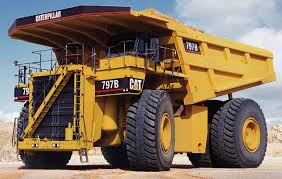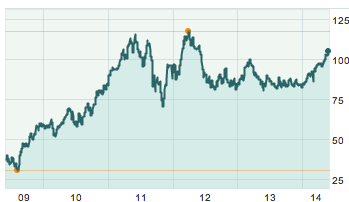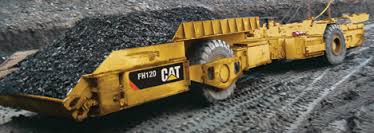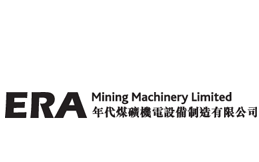Caterpillar highlights risks to global growth with revenue growth lacking
Apr 26, 2014 at 8:10 am in General Trading by contrarianuk
I’ve always followed the shares of Caterpillar (CAT), the global construction equipment maker, since the company always gives an excellent insight into overall economic health around the world. Their management team always give a forecast of global growth based on what they are seeing in their various divisions which is useful to gauge sentiment in places like China, Europe and the United States.
The shares at $104.5 are at a two year high and way above the $25 level that they saw back in the depths of the financial crisis of 2008/2009.
On Thursday the company announced first quarter results which beat profit expectations as well as increasing its full-year profit outlook. But what stood out for me was that revenue growth continues to be lacking, a classic case of financial re-engineering for investors via share buy backs and cost cutting. The company expects full year revenues of $56 billion for 2014 compared with $60 billion in 2011, $66 billion in 2012 and $55.7 billion in 2013. With equipment sales pretty anaemic in the likes of China.
Caterpillar reported first quarter 2014 earnings of $922 million, or $1.44 a share, versus $880 million, or $1.34 a share in the same period in 2013. Adjusted first-quarter earnings were $1.61 a share, beating estimates of $1.21 per share. Revenues were flat at $13.24 billion, compared with $13.21 billion the year before and ahead of expectations of $13.17 billion. The company increased its full-year profit outlook by 25 cents to $6.10 a share, excluding restructuring costs, compared with a previous consensus of $5.85 .
The company said construction sales would grow twice as fast as previously forecast, at 10 per cent, and would offset a 20 per cent decline in mining machinery sales. Sales for Caterpillar’s mining equipment segment during the quarter fell 37 per cent to $2.1 billion, compared with the same period last year. Construction equipment sales rose 20 per cent to $5.1 billion, driven by North America, while energy and transport equipment sales rose 8 per cent to $4.8 billion.Retail machinery sales in the three months to March fell 12 per cent compared with the same period last year, driven by a 46 per cent drop in mining equipment sales. Construction sales rose 9 per cent. March was the 16th straight month Caterpillar saw a drop in retail machinery sales. North America was the only region showing positive overall sales, with retail machine sales up 6 per cent during the quarter. Sales in Asia Pacific, Latin America and the Europe, Africa and Middle East region all fell 20 per cent or more.
So what does all this mean for global investors?
Caterpillar is basically saying that global growth will be OK, but the Chinese infrastructure boom of previous years is not going to be repeated anytime soon. So the focus is profits enhancement through cost management. Capital expenditure was down around 50% and head count was down to 116,579 total full time employees in Q1, down 8,295 from 124,874 a year ago. All the cost cutting meant that construction operating margin improved to 13.6 per cent from 5.5 per cent last year.
CEO Doug Oberhelman said . “We understand we don’t control the economy and have instead focused on what we can improve. We’re lowering costs, improving cash flow and driving value for our customers through the continued deployment of our lean manufacturing initiatives. We see the benefits of these actions in our first-quarter results and in improving market position for many of our products.”, “China is one example of both the potential and uncertainty we face. During my visit a few weeks ago, it was evident the Chinese construction industry is facing challenges; however, I was pleased with how Caterpillar is performing compared to our competitors. I came away optimistic about how we are executing our China strategy as we implement our proven business model along with our dealers and suppliers who continue to invest in China. At the same time, Chinese leaders are in the midst of transitioning the world’s second largest economy to a longer-term, more sustainable growth model while maintaining social stability. This is an enormous task that carries risks for the world economy.”
Caterpillar stumbled in 2013 after being caught out by fraud in China after buying ERA Mining Machinery Ltd for $677 million in 2012. The dash for growth in the world’s second largest economy was so enticing at the time that CAT’s management through caution to the wind and ultimately frittered away hundreds of millions of dollars. The ERA deal followed the $8.8 billion purchase of Bucyrus, a mining and earth-moving company with significant China operations.
ERA was the holding company for Zhengzhou Siwei Mechanical & Electrical Equipment Manufacturing Co Ltd, one of China’s biggest makers of hydraulic coal-mine roof supports which prevent underground coal mines from collapsing and was listed in Hong Kong.
On January 18, 2013, Caterpillar said it had discovered “deliberate, multi-year, coordinated accounting misconduct” at Siwei meaning that CAT had to take an impairment charge of $580 million (86 percent of the value of the original deal.). The company says it was caught unaware by the problems at Siwei and only discovered them in November 2012, five months after the deal closed but many commentators reported that Caterpillar chose to ignore potential red flags.
Investigations in late 2012 found that sales had been double booked, costs were sometimes allocated to incorrect projects or been missed from the balance sheet and that the inventory was a mess. As big a scandal as the Chinese timber company, Sino Forest collapse around the same time after being exposed by shorter Muddy Waters. Caveat Emptor was the watch word in terms of buying Chinese assets, with lack of accounting transparency a big problem.
Caterpillar’s 2014 forecast is as follows:
Overall, our expectation for world economic growth in 2014 has changed little from the outlook we provided with our 2013 year-end financial release in January of 2014. We anticipate global economic growth in 2014 of about 3 percent, up from about 2 percent in 2013. Economic indicators that signaled improvement in global economic conditions during the last half of 2013 continued to indicate improvement during the first quarter of 2014. Interest rates are at record lows in many countries, and low inflation coupled with elevated unemployment should cause most central banks to keep interest rates low throughout 2014.
Despite recent softness in some commodity prices, improvement in the world economy should increase demand for mined commodities and energy, keeping commodity prices at levels that are profitable for production. As a result, we expect mine production will continue to increase in 2014. While most commodity prices should be high enough to make investments attractive, we expect mining companies will remain cautious with equipment investments, and we expect continued decreases in mining capital expenditures for equipment in 2014.
Developed Countries
Economic policies in developed countries should continue to support growth in 2014. Governments reduced budget deficits in 2013 well below the recent financial crisis highs, which should allow them to focus less on austerity actions in 2014. Inflation in most developed countries declined in early 2014, and economies are operating well below potential. Low inflation and slow progress on restoring employment should allow central banks to maintain low interest rates. We expect economic growth in developed countries will improve to 2 percent in 2014.
Developing Countries
Growth in developing countries has slowed over the past few years to around 4.5 percent. The slowdown has been broad based, including China, India, Russia and Brazil. While we do not believe inflation has been a major problem in most developing countries, some have increased interest rates over the past year and we believe it is beginning to negatively impact economic growth. In 2014, some central banks have further increased rates, or maintained high interest rates, in part to defend their currencies. As a result, we believe interest rates are near a peak and should remain close to current levels throughout 2014, which could limit growth. As a result, we expect overall growth in developing countries to remain near 4.5 percent in 2014.
Risks
There are numerous risks in the world economy. Notable risks include growth in Europe and China and heightened geo-political risk in several developing regions, particularly Russia, Ukraine, Africa and the Middle East.
The Eurozone economy is recovering but is far from healthy. The ongoing decline in business lending, slowing inflation and recent strengthening in the euro are all concerns. The unwillingness of the European Central Bank to take more aggressive actions risks leaving the economy struggling for years. Continued weak growth would make it difficult for businesses to maintain existing operations, let alone make new investments.
Our outlook assumes that China’s economy will grow near 7.5 percent in 2014, similar to the past two years. That rate of growth should support improvements in the machine industry and increase commodity demand. However, Chinese leaders are in the midst of major reforms to transform the world’s second largest economy to a more sustainable growth model while maintaining social stability. In the short term, these efforts could impact the economy and the industries we serve.
Political and labor problems could slow growth in the Africa/Middle East region, particularly in mining and oil- producing countries. Also, 2014 growth could slow further in the CIS region due to higher interest rates and political unrest.
Contrarian Investor UK
IMPORTANT: The posts I make are in no way meant as investment suggestions or recommendations to any visitors to the site. They are simply my views, personal reflections and analysis on the markets. Anyone who wishes to spread bet or buy stocks should rely on their own due diligence and common sense before placing any spread trade.






The allegations against Sino-Forest have not been proven. On the contrary, Ned Goodman blamed the Ontario Securities Commission for the company’s collapse. In December 2013, the Chinese Court also ruled that the allegations against Sino-Forest are groundless.
It is weird that the OSC refused to recognize the Chinese government Forestry Bureaus’ confirmation of Sino-Forest’s forest assets in China, implying that the Chinese government was covering up the fraud, while in the Chinese law, the FBs are the authorized departments for all the disputes on forestry resources in China.